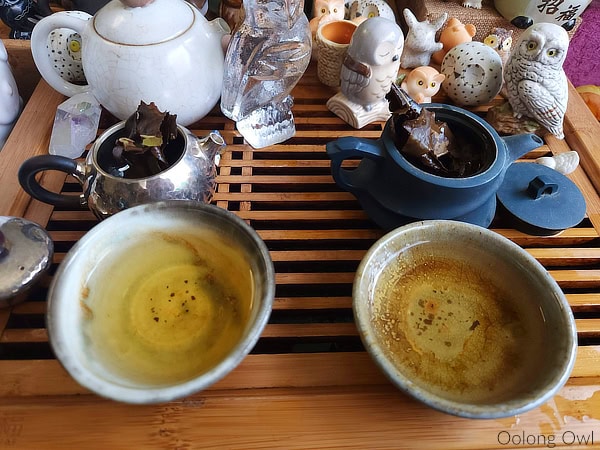During the 2024 Cascadia Tea Festival, I did 20-minute aged white tea tasting in silver teaware. I had hypothesized that silver could greatly change the taste of aged white tea, potentially for the better. For the comparison, I used my seasoned clay teapot dedicated to aged white vs my persimmon silver teapot – both similar in size.

For those who couldn’t make it to the Seattle area, I did a tasting by myself to check the theory. Note, I did not use these teas in the festival tasting. For that, I used an assortment of white teas from 2008 to 2018 from White2tea, Moychay, and a couple of vendors who are no more. I learned for tea tasting classes to have 3 sets of teas because I get sick of drinking teas back to back between sessions.
2018 Jingmai 3 Aroma Bai Mu Dan from Yunnan Sourcing
The 2028 Jingmai 3 Aroma loose leaf has been aging in my stash since 2018. I purchased this tea in volume for aging.

With a steep, the wet leaves were quite aromatic but the clay was even more so. That is to be expected due to the seasoned clay.
In silver, the 3 Aroma is sweet, lightly floral, and milky with a mineral rocky note that echos along. Very crisp and sweet! However, in clay the 3 Aroma tasted rich and had a salivation effect there that silver doesn’t. The flavor is woody, herbal, and bruised floral, along with astringency.
I like the silver a bit more, but I prefer the salvation effect that gives the tea more interest. Since 2018, 3 Aroma lost the green vegetal notes and it can survive boiling water without getting as astringent.
For fun, I used a silver teacup paired with the silver teapot. The double silver tasted like I sterilized the tea to taste ultra bright and sweet, with clean herbaceous vegetable notes. No other flavor notes were present and the body was thin. I didn’t think this was good at all, but is a taste some may have.

2009 Wet Storage Silver Needle
And now for the ultimate test.
I’ve had this tea for 5 years and it has been stored sealed without any airing out. I believe it spent most of its life in Guandong. The leaves smell like funky floral mothballs. I do not like wet-stored white tea, so this tea, along with others, lives in the bottom of my stash. For my personal white tea aging, everything is sealed airtight with no added humidity or temperature.
In clay, the 2009 Silver Needle tasted like musky sour oak trees and leaves and had some floral aftertaste but dominated by the sourness of the wet storage. Rest assured, this tea is much worse in a gaiwan, my seasoned teapot helps even it out and adds a bit of sweetness.
Steeped in a silver teapot, the wet-stored 2009 silver needle is floral, oak, and tree resin with the aftertaste of sunflowers. The floral here is a stale jasmine, like the aftermath of a visit to Bath Body Works in the mall. It is surprisingly drinkable, but still not great.
During my tasting sessions at the Cascadia Tea Festival, I was also curious on what the audience’s opinions on tea in silver. It seemed close to 50% liked the silver more for brighter sweeter flavors, whereas others preferred the depth of flavor in seasoned clay. As the white tea got older, the majority preferred it in silver. But those who enjoy aged tea flavors, still prefer seasoned clay. With everything tea, it all depends on your tastes.
The 2008 tea I presented wasn’t as bad as this 2008 Silver Needle, I wasn’t that mean.






